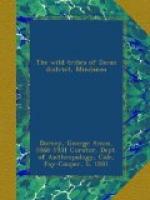With slight variation, this is the dance used on all occasions. At certain ceremonies small gongs, or the bolang bolang,[1] replace the agongs, and at times also a single dancer will accompany himself on the kodlon—a long wooden guitar with rattan strings (Plate XXXb).
[1] An instrument made by placing a small board on a rice mortar. This is pounded or beaten with short sticks, or with the wooden pestles.
In this description we have named a large share of the musical instruments used by the Bagobo. The women frequently play on a sort of guitar made of a section of bamboo from the outside of which narrow strings are cut. These are raised and made taut with small wooden bridges and are then picked with a stick or the fingers (Fig. 33). Bamboo Jew’s-harps and mouth flutes are played by the men, but the nose flute, so common in most parts of the Philippines, was not seen in use here.
FIG. 33. TAW-GAU OR BAMBOO GUITAR.
The ceremonies and dances are so closely associated with every day affairs that in the description of the life of the people up to this point we have left only a few still to be discussed. These are, in the main, very similar throughout the Bagobo belt, but to avoid confusion the description here given of the two greatest events of the year—the GinEm ceremony and the human sacrifice—deals with Cibolan, unless expressly stated to the contrary.
The greatest of all Bagobo ceremonies—the GinEm—may be given by the datu within three or four months after the appearance of the constellation Balatik, when the moon is new or full. Its object is to thank the spirits for success in war or domestic affairs, to ward off sickness and other dangers, to drive away the buso, and finally to so gratify the spirits that they will be pleased to increase the wealth of all the people. Datu Tongkaling expressed a belief that this ceremony is in a way related to the rice harvest, “for it is always made when there is plenty of rice in the granaries.” It appears to the writer, however, that this ceremony probably originated in connection with warfare.
According to the tales of the old men, it was formerly the custom to go on a raid before this ceremony was to take place, and successful warriors would bring home with them the skulls of their victims which they tied to the patan’nan.[1] It seems also to have been closely associated with the yearly sacrifice, for it was never made until after the appearance of the constellation Balatik, and without doubt a sacrifice frequently did take place during the first day of the ceremony, at the time the decorated poles were raised. However, such an offering at this time did not relieve the datu from the obligation of making the regular sacrifice.
[1] Ceremonial poles dedicated to Mandarangan and Darago. In Digos and Bansalan the skulls were not taken but hair cut from the heads of enemies was placed in the swinging altar balakat, and were left there until the conclusion of the ceremony.




